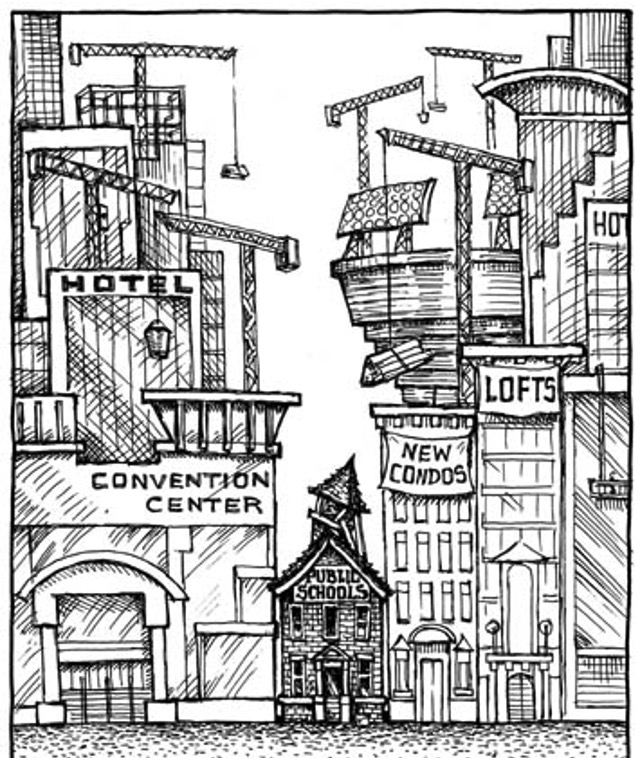Comments
PLANNING WATCH - The film LaLa Land has a great opening shot of drivers dancing on cars trapped in a freeway traffic jam. While Hollywood’s creativity was on full display, day-to-day reality is another story. When stuck in traffic, Angelenos silently suffer, listen to radios and podcasts, or catch up with friends on their cell phones. Dancing on gridlocked cars only happens in movies.
But there is no reason why the declining quality of life in Los Angeles should be camouflaged by imaginative movie scenes and municipal plans and programs that are never monitored. If the city’s plans were monitored, they would reveal the bad news that the officials and their booster buddies try to hide. Day-to-day life in Los Angeles is getting tougher. This is why those looking for accurate municipal data that documents these trends require Divine intervention to find a City Hall employee willing to explain why the city’s plans have failed and why life in Los Angeles has become so hard.
Nevertheless, plan monitoring is not only common sense, but it should be part of every planning process. To understand why, you only need to look at the business world. Every successful company determines if its business plans are working by carefully analyzing sales, costs, and profitability data.
For similar reasons, California's General Plan Guidelines spell out a similar monitoring approach:
“Annual Progress Reports: After the general plan has been adopted, Government Code section 65400(a)(2)(A) requires the planning agency to provide an annual report to their legislative body, OPR, and HCD on the status of the plan and progress in its implementation, pursuant to Government Code section 65583(c)(3) (Id. at § 65400(a)(2)(B)).
Until 2019, Charter Cities, like Los Angeles, were exempt from this annual reporting requirement, but this rule now applies to them. Los Angeles now submits a General Plan Annual Report to the Governor’s Office of Research and Planning. Unfortunately, LA’s report is only a compendium of adopted plans and implementation ordinances. No reader knows if LA's adopted plans have achieved their goals. In other words, Los Angeles is still flying blind, and the quality of life for most its residents continues its long and poorly measured downward trajectory.
Nevertheless, LA’s General Plan also contains clear but totally ignored monitoring requirements:
General Plan Framework Growth Monitoring requirements: After the Framework Element is adopted, the City will establish a growth monitoring program that will provide important information regarding the accuracy of future growth estimates and the distribution of that new development by community plan area. This monitoring program will annually document what has actually happened to the City's population levels, housing construction, employment levels, and the availability of public infrastructure and public services. Information on environmental conditions will also be monitored on a yearly basis to maintain and update an environmental database . . .
The information from such a monitoring system will be presented to the City Council in the form of an Annual Report on Growth and Infrastructure, which can be used as the basis for revision of policies as needed to meet the goals of the Framework Element . . .
The General Plan’s Land Use Element contains LA’s 35 Community Plans, each of which reiterates the Framework’s monitoring requirements. For example, the 2001 Wilshire Community Plan contains the following:
The Framework Element of the General Plan commits the Department of City Planning to develop a monitoring system and prepare an annual report on growth and infrastructure, to be submitted to the City Planning Commission, Mayor, and City Council. In the fifth year following plan adoption (and every five years thereafter), the Director of Planning shall report to the Commission on the relationship between population, employment, housing growth and plan capacities. If growth has occurred faster than projected, a revised environmental impact analysis will be prepared, and appropriate changes recommended to the community plan. These plan and zoning changes shall be submitted to the Planning Commission, Mayor, and City Council as specified in the Los Angeles Municipal Code.
What is going on? The big question is why LA has refused to monitor its plans despite these state and local requirements? Since the City Hall officials have avoided this question, these are my explanations:

City Hall officials are so wary of monitoring results that they have ignored these monitoring requirements. Through other sources, however, astute readers know that LA’s population declined by 200,000 people during the Covid 2019 epidemic. They also know that many businesses have failed and that homeless counts have steadily increased despite stop gap programs, like Inside Safe, and LAPD harassment of homeless encampments.
City officials know that climate change has arrived. They also realize that programs that claim to reduce Green House Gas emissions offer a convenient justification for new, high-density apartments (built for well-off tenants who own their own cars and rarely take transit). Furthermore, many of the building pads for these new market rate apartments were previously demolished rent-stabilized apartments. The result of this deliberately unmonitored, pseudo “climate friendly” land use approach is an increase in driving and reduced supply of low-priced apartments.
For public officials who believe the neo-liberal doctrine that the housing crisis results from a housing shortage created by legacy zoning ordinances, contradictory hard data is suppressed. It would directly rebut the dubious planning theories they invoke to justify the sweetheart deals they routinely dish out to real estate speculators at the public’s expense.
Nevertheless, the inexcusable results are there for all to see. Life for most Angelinos is getting harder, with or without City Hall monitoring data that documents these disturbing trends.
(Dick Platkin is a retired Los Angeles city planner who writes about local planning issues for CityWatchLA. He is a board member of United Neighborhoods for Los Angeles (UN4LA). Previous Planning Watch columns are available at the CityWatchLA archives. Please send any questions to [email protected].)
















